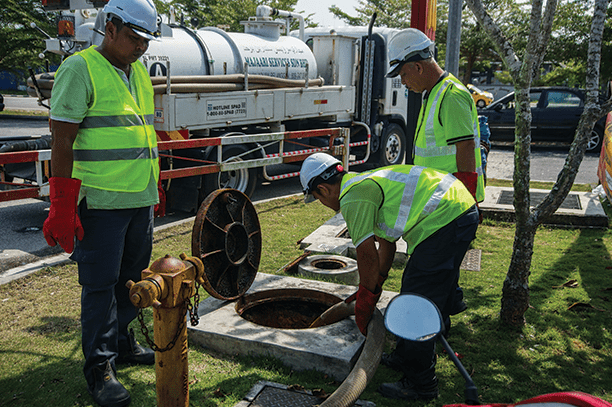Did you know that over one million septic tank systems exist across the United States? These workhorses handle wastewater from homes not connected to public sewer lines. A septic tank is basically a primary settling chamber that separates solids from liquids. Over time, these solids accumulate, requiring periodic septic pumping to maintain proper functioning. Neglecting this process can lead to a variety of problems, including:
Clogged drainpipes:
Solid waste overflowing from the tank can clog pipes, causing backups in your home’s plumbing system.
Environmental damage:
Raw sewage overflows can contaminate soil and groundwater, posing a risk to human and ecological health.
Structural damage:
A full septic tank can put undue stress on the tank itself, leading to cracks and leaks.
In this blog post, we’ll explore the top three mistakes you must avoid to ensure a smooth septic tank pumping experience and protect your investment in proactive septic tank management.
Mistake #1: Not Knowing Where Your Septic Tank Is Located – A Treasure Hunt for Your Home’s Plumbing Health
Believe it or not, many homeowners near Molalla, Newberg, Sherwood, Wilsonville, and surrounding locations are in the dark about the whereabouts of their septic tank. This seemingly basic piece of information is crucial for scheduling professional septic pumping services and maintaining a healthy septic system.
Here are some feasible tips to help you unearth the location of your septic tank system:
1. Digging Through:
Your property records are a goldmine of information, and the location of your septic tank might be hiding there. Look for a plot plan or deed that mentions the tank’s placement.
2. Questioning the Previous Tenant:
If you’re a recent homeowner, don’t hesitate to contact the previous owner and politely inquire about the septic tank’s location. They might have a map or recollection of its placement.
3. The Case of the Curious Cleanout:
Cleanouts are access points to your septic system, often appearing as raised lids or pipes protruding from the ground. These can be subtle, so keep an eye out for anything suspicious in your yard that might be a clue.
4. Calling in the Septic Tank Experts:
If you’ve exhausted all other options, consider hiring a professional septic service company like American On-Site Septic. We have specialized tools and equipment like radio frequency locators that can pinpoint your tank’s exact position with ease. Contact us at (503) 554-0915 for an accurate estimate.
Mistake #2: Not Preparing the Area Around the Tank – Setting the Stage for a Smooth Septic Pumping Experience
A successful septic tank pumping process is all about smooth operation. The last thing you want is the pumping truck getting stuck in a muddied mess or struggling to access the tank due to overgrown vegetation. Here are some steps you can take to prepare the area around your septic tank for a seamless pumping experience:
1. Clearing the Clutter:
Think of a 10-foot radius around your septic tank access point as an exclusion zone. Remove any furniture, landscaping features, or debris hindering the technician’s work. The professionals at American On-Site Septic agree that a clear workspace makes the job faster and more efficient.
2. Taming the Jungle:
Overgrown bushes and trees can be a nightmare for septic tank pumping. Trim back any vegetation that might obstruct access for the pumping truck. Not only will this make the job easier, but it will also prevent potential damage to your landscaping.
3. Marking the Spot:
If your septic tank access point is buried, don’t leave the technician guessing. You can use brightly colored flags or stakes to mark its location for easy identification. This simple step saves time and ensures the septic system pumping contractor is working in the right spot.
4. Parking Smarts:
Your driveway may seem like the perfect parking spot, but avoid placing vehicles or heavy equipment directly on or near the septic tank lid. The weight can cause the lid to cave in, creating an additional problem. Designate a safe parking area away from the tank for a stress-free pumping experience.
Mistake #3: Putting the Wrong Things Down the Drain – Protecting Your Septic System’s Delicate Ecosystem
What you flush down the drain has a profound impact on the health of your septic system. Think of your septic tank as a delicate ecosystem teeming with beneficial bacteria that break down waste. Certain items can disrupt this balance, leading to clogs, blockages, malfunctions, and even costly repairs.
Here are some drainage don’ts to keep your septic system happy and healthy:
1. The FOG Factor:
Fats, oils, and grease (FOGs) are the enemies of your septic system. These substances solidify and clog pipes, preventing proper wastewater flow. Avoid pouring cooking oil, grease, or greasy food scraps down the drain.
2. Coffee Grounds:
Coffee grounds can clump together and form a thick layer that’s difficult to decompose. Consider composting your coffee grounds instead.
3. Eggshells and Food Scraps:
These might seem harmless, but they can attract grease and encourage the growth of solids-consuming bacteria that can disrupt the natural balance in your septic tank. Scrape food scraps into the trash and dispose of eggshells responsibly.
4. The Non-Biodegradable Blues:
Diapers, wipes, dental floss, and feminine hygiene products are designed not to break down. Flushing these items can lead to severe clogs and system malfunctions. So, they should always be disposed of properly in the trash bin.
5. Chemicals:
Using harsh chemicals such as drain cleaners and bleach might seem like a fast solution for clogged drains, but they can seriously harm your septic system. These chemicals kill the good bacteria needed to break down waste and can damage pipes. Consider using eco-friendly options or seek advice from a credible professional like American On-Site Septic before using chemical products.
Routine septic system maintenance and mindful practices are key to preserving the health and longevity of your septic system. By avoiding these common mistakes, you can ensure smooth operation and avoid costly repairs down the line.
Worst Times to Pump Your Septic Tank
While regular pumping is crucial, timing also plays a role. Avoid scheduling a pumping during these times:
1. Heavy rain:
Excessive rainfall can saturate the drainfield, hindering its ability to absorb treated sewage and wastewater.
2. Freezing temperatures:
Frozen ground can make accessing the tank difficult and damage pumping equipment.
3. Right before a large gathering:
A sudden influx of wastewater can overwhelm your septic system if it’s nearing capacity.
Tips for a Smooth Septic Tank Pumping
By following these tips, you can ensure a stress-free septic tank pumping experience:
1. Locate Your Septic Tank
As mentioned earlier, knowing your tank’s location is crucial. If you’ve already unearthed this hidden treasure, you’re ahead of the game! But if not, you can hire a credible company like American On-Site Septic.
2. Scheduling and Communication
Once you’ve located your tank, schedule your pumping service.
3. Choose a Reputable Company
Look for a licensed and insured company with a proven track record, like American On-Site Septic, which has been serving Oregon communities for years.
4. Schedule in Advance
Depending on your location and season, scheduling ahead might be necessary. Peak seasons see increased demand for septic services.
5. Communicate Clearly
When contacting a company, be prepared to provide information about your property, tank size (if known), and any recent drainage issues. Clear communication ensures the technician arrives with the right equipment and can answer your questions.
6. Optimizing Your Septic Tank Health for the Long Term
Here are some additional tips to keep your septic system functioning smoothly between pumpings:
7. BeCautious
Only flush toilet paper and human waste. Avoid flushing anything that can’t decompose easily, like coffee grounds, eggshells, or feminine hygiene products. These items can clog your pipes and disrupt the delicate balance of bacteria in your septic tank.
8. Water Conservation
While water conservation is always a good practice, be mindful of sudden spikes in water usage. Large laundry loads or filling a swimming pool can overwhelm your septic system. Space out water-intensive activities and consider installing water-efficient appliances to reduce overall water consumption.
9. Schedule Regular Inspections
In addition to pumping, consider having your septic system inspected by a professional like American On-Site Septic every 2-3 years. This proactive approach can help identify minor issues before they become major problems. To avail of our professional services, feel free to reach out to our team at (503) 554-0915.
Final Takeaway
If you’re looking for professional septic tank pumping services in Molalla, Wilsonville, Newberg, and nearby locations, your search ends here. Since 2003, our team at American On-Site Septic has been providing reliable, efficient, and affordable septic services to our customers in the greater Willamette Valley. Our team of experienced professionals is equipped with specialized tools and expertise to locate your septic tank accurately, prepare the area for pumping, and provide expert advice on maintaining your system’s health.
We are licensed, bonded, and insured and maintain all the documentation you need to hire a contractor confidently.
Contact us at (503) 554-0915 to schedule an appointment with our team today.






